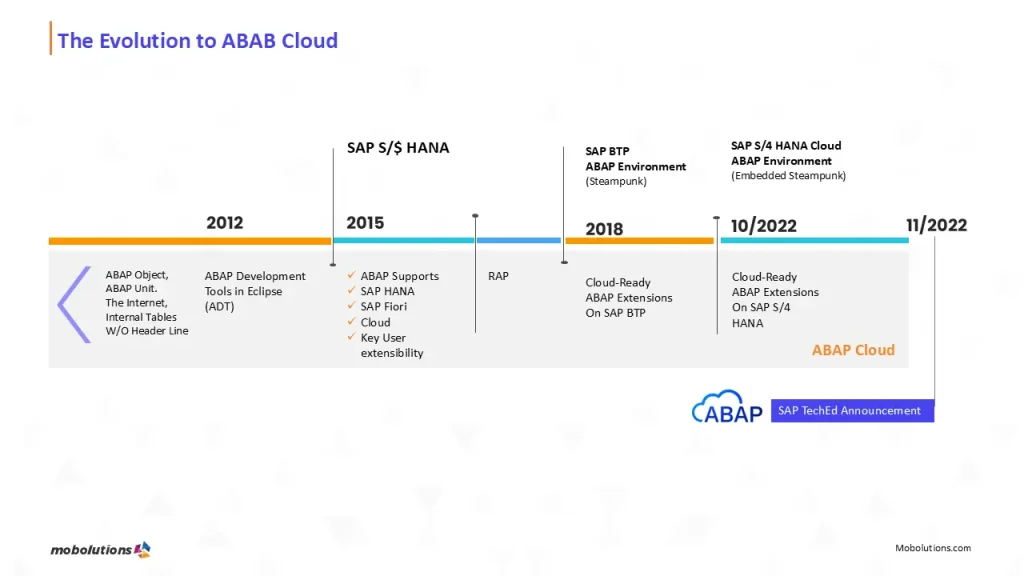What Is ABAP Cloud and Why It’s Key to SAP’s Future-Ready Development
For decades, ABAP has driven mission-critical SAP systems. Today, with the shift of businesses towards modular, scalable, and cloud-native architecture, ABAP Cloud revolutionizes the development of enterprise applications.
It is not a product but rather a new paradigm for developing that is designed to assist developers in creating solid and adaptable solutions that function really well on SAP S/4HANA Cloud, SAP BTP, even on on-premise systems. With defined boundaries, upgrade stability, and cloud-readiness as its pillars, ABAP Cloud is SAP’s formula for future-proof innovation.
This post breaks down what ABAP Cloud is, how it fits into SAP’s modern strategy, and why it matters for your development and digital transformation journey.
The Evolution of ABAP
In order to understand ABAP Cloud, it is helpful to recall how ABAP came about. ABAP (Advanced Business Application Programming) has been the basis programming language of SAP systems for over four decades. ABAP applications in the past were highly integrated with the SAP core, being built directly within the ERP system and often containing deep customizations and adaptations.
This approach worked well in on-premises systems, where businesses had full control. However, it created challenges in terms of upgrading stability, maintenance, and scalability. As SAP transitions toward a cloud-first world, traditional ABAP development practices are no longer sufficient.
Enter ABAP Cloud—a new model that enables clean, efficient, and modular development, built from the ground up for the cloud era.
What is ABAP Cloud?
ABAP Cloud is a set of design principles, tools, and programming techniques that help developers build applications that are:
- Cloud-ready
- Upgrade-safe
- Modular
- Aligned with SAP’s clean core strategy
It is based on a restricted, clean subset of the ABAP language, and enforces the use of released APIs and whitelisted objects only. This ensures that custom developments do not break during upgrades, are easier to maintain, and can be reused across SAP platforms.
ABAP Cloud can be used across:
- SAP S/4HANA Cloud
- SAP BTP ABAP Environment
- SAP S/4HANA On-Premises (with restrictions)
Key Components of ABAP Cloud
-
ABAP RESTful Application Programming Model (RAP)
At the heart of ABAP Cloud is RAP—a modern, model-driven programming paradigm that makes it easier to develop business applications with clean architecture.
RAP is built on three core pillars:
- Core Data Services (CDS) – for defining data models
- Behavior Definitions – to define business logic (create, update, delete operations, validations, etc.)
- Service Bindings – for exposing services via OData or Web APIs
This layered approach promotes reuse, separation of concerns, and clean coding practices, which are essential in cloud-native development.
-
Released APIs and Whitelisted Objects
ABAP Cloud restricts developers from using only public, released APIs and objects provided by SAP. This ensures that:
- The core system remains untouched
- Upgrades do not break custom code
- Custom extensions are resilient and stable
This is a major shift from traditional ABAP development, which allowed direct access to internal SAP objects.
-
Cloud Qualities Built-In
ABAP Cloud is designed with cloud-native qualities:
- Multitenancy support
- Security by design
- High performance
- Upgrade stability
- DevOps integration
These traits make it easier to develop scalable and robust applications that are cloud-compliant from day one.
Why ABAP Cloud Matters for Your SAP Strategy
-
Future-Proof Your Custom Code
SAP is moving fast towards the cloud with platforms like SAP S/4HANA Cloud and SAP BTP. Custom code that was once deeply embedded in the ERP system must now be decoupled and developed in ways that are sustainable over time.
ABAP Cloud ensures that:
- Your developments align with SAP’s long-term roadmap
- Applications stay compatible across releases
- Technical debt is minimized
By avoiding classic modifications and sticking to released APIs, you build applications that are automatically upgrade-compatible and cloud-ready.
-
Accelerated Innovation Through RAP
RAP enables faster development by using reusable components, standard patterns, and declarative programming. It supports:
- OData services for front-end consumption
- Service-oriented architecture
- Layered development with clear separation of data, logic, and service exposure
This not only improves developer productivity but also results in cleaner, easier-to-maintain applications.
-
Unified Development Across Cloud and On-Premises
One of the greatest strengths of ABAP Cloud is its consistency across deployment models. Whether you are:
- Building custom apps in SAP S/4HANA Cloud
- Creating side-by-side extensions on SAP BTP
- Enhancing your S/4HANA on-premises system with upgrade-safe methods
…you use the same language, same tools, and same model.
This unified approach simplifies training, reduces complexity, and enables a hybrid strategy as businesses move toward the cloud at their own pace.
-
Clean Core and Safe Extensibility
SAP strongly encourages a “clean core” strategy—meaning no custom code should interfere with the standard SAP system. ABAP Cloud supports this by:
- Offering in-app extensibility (through extension points)
- Promoting side-by-side extensibility (on SAP BTP)
- Enforcing use of public APIs
This results in less friction during upgrades, better maintainability, and more sustainable systems.
-
Unlock the Full Potential of SAP BTP
Adopting ABAP Cloud on SAP BTP opens access to a broader ecosystem of services, such as:
- Workflow Management
- Business Rules
- Event Mesh
- SAP Build tools
Additionally, ABAP Cloud works seamlessly with:
- Modern DevOps pipelines
- Git-based version control
- Transport Management System (TMS)
- ABAP Development Tools in Eclipse
This turns your SAP landscape into a platform for innovation, not just transaction processing.
Visual Comparison: Traditional ABAP vs. ABAP Cloud
| Feature | Traditional ABAP | ABAP Cloud |
| Environment | On-premises | Cloud-native and on-prem ready |
| Code Access | Full system access | Restricted to released APIs |
| Upgrade Stability | Risk of breakage | Stable and future-proof |
| Development Model | Procedural | RAP (Model-driven) |
| Extensibility | Tight core coupling | Clean core with extensions |
Conclusion: The Bridge to a Cloud-Ready Future
ABAP Cloud is more than just a new way of coding—it’s a strategic enabler for businesses looking to modernize their SAP environments. By enforcing clean architecture, API-based extensibility, and upgrading stability, it provides a smooth transition from legacy ABAP practices to modern, agile development in the cloud.
Whether you’re fully on the cloud, staying hybrid, or still on-premises, ABAP Cloud offers a unified, powerful, and future-proof way to build and extend SAP applications.
Start embracing ABAP Cloud now to stay ahead of the curve—and ensure your SAP customizations are ready for the future. For quick guidance, get in touch with our experts by contacting us at info@mobolutions.com.






